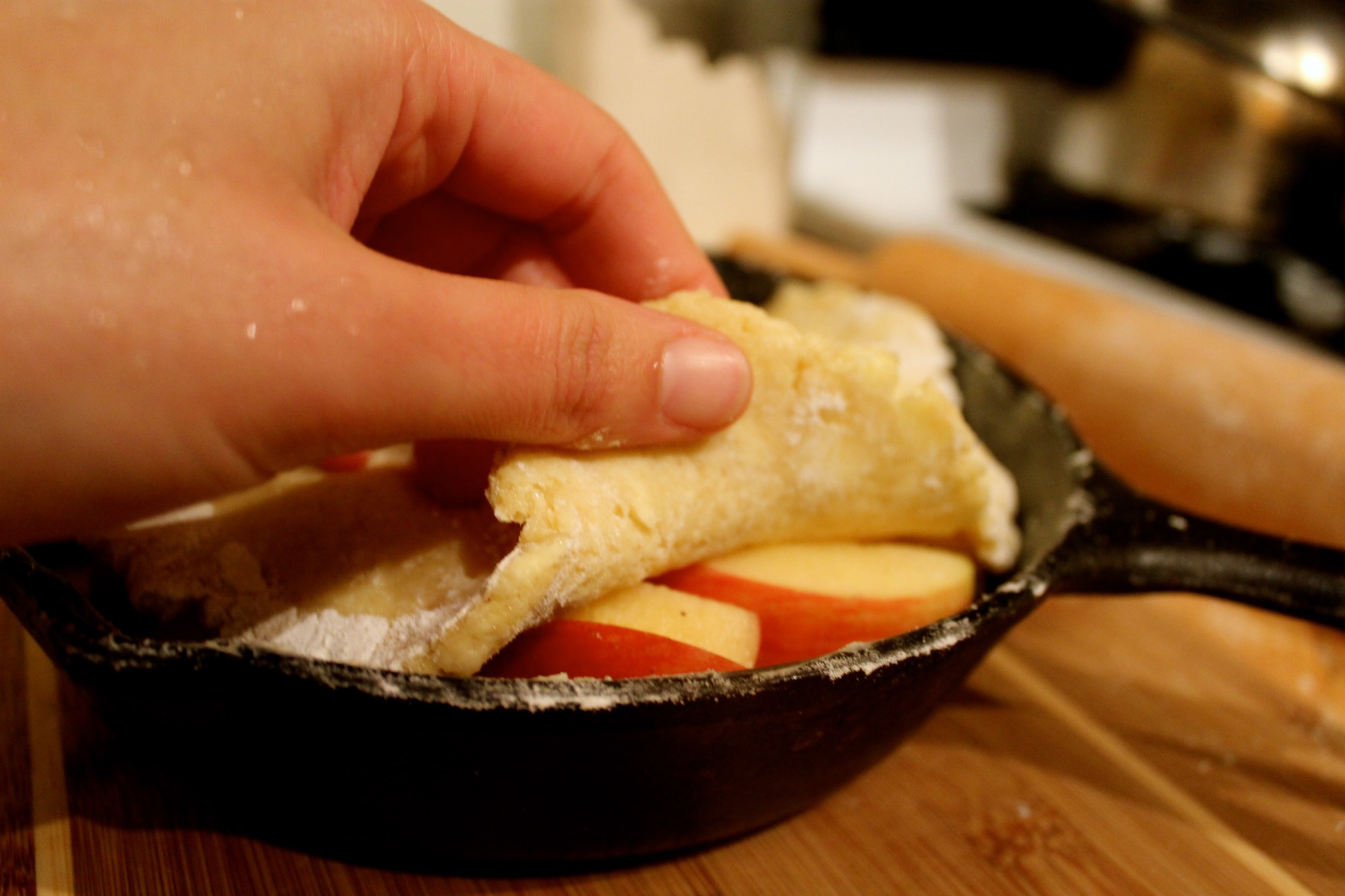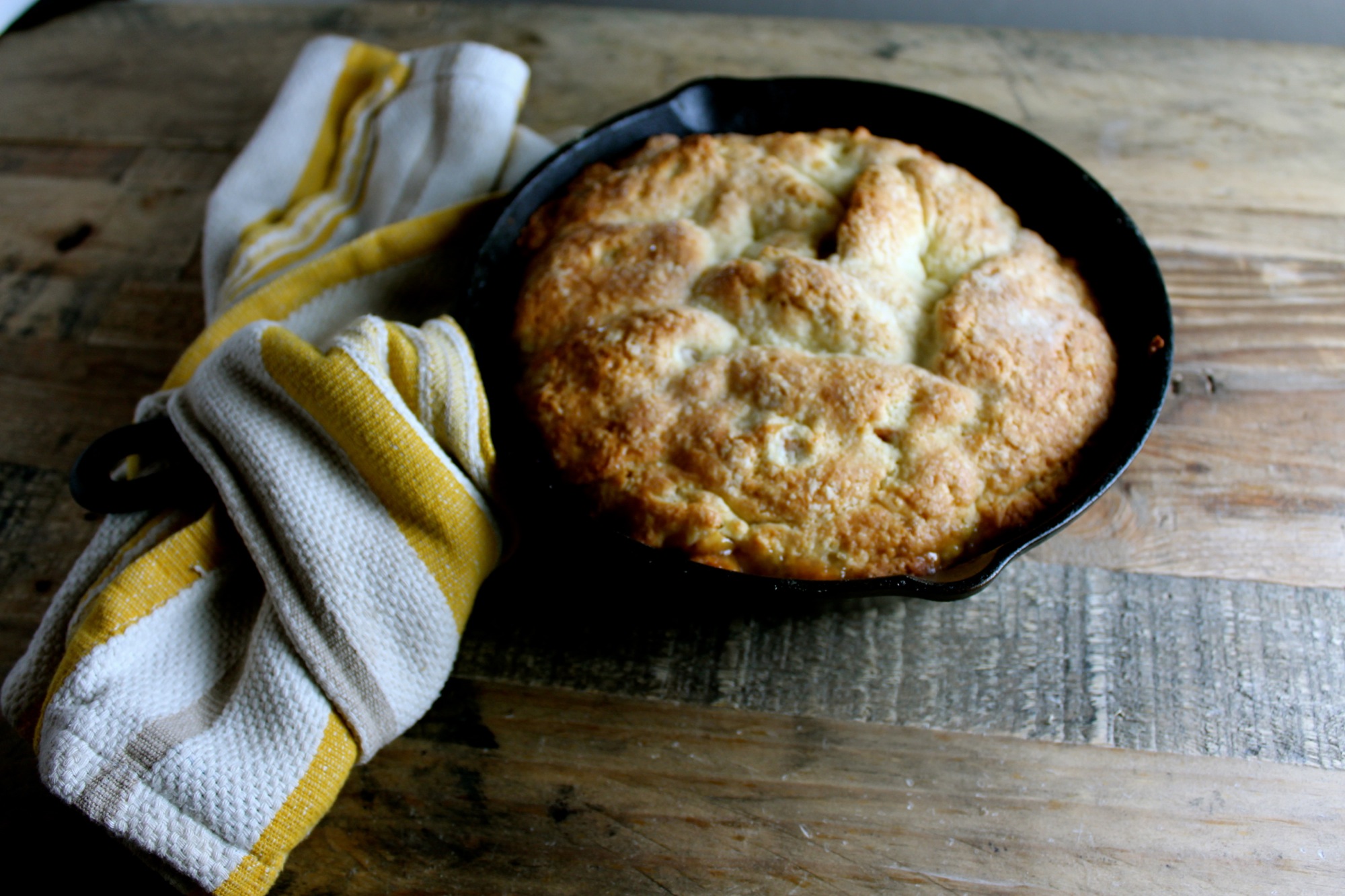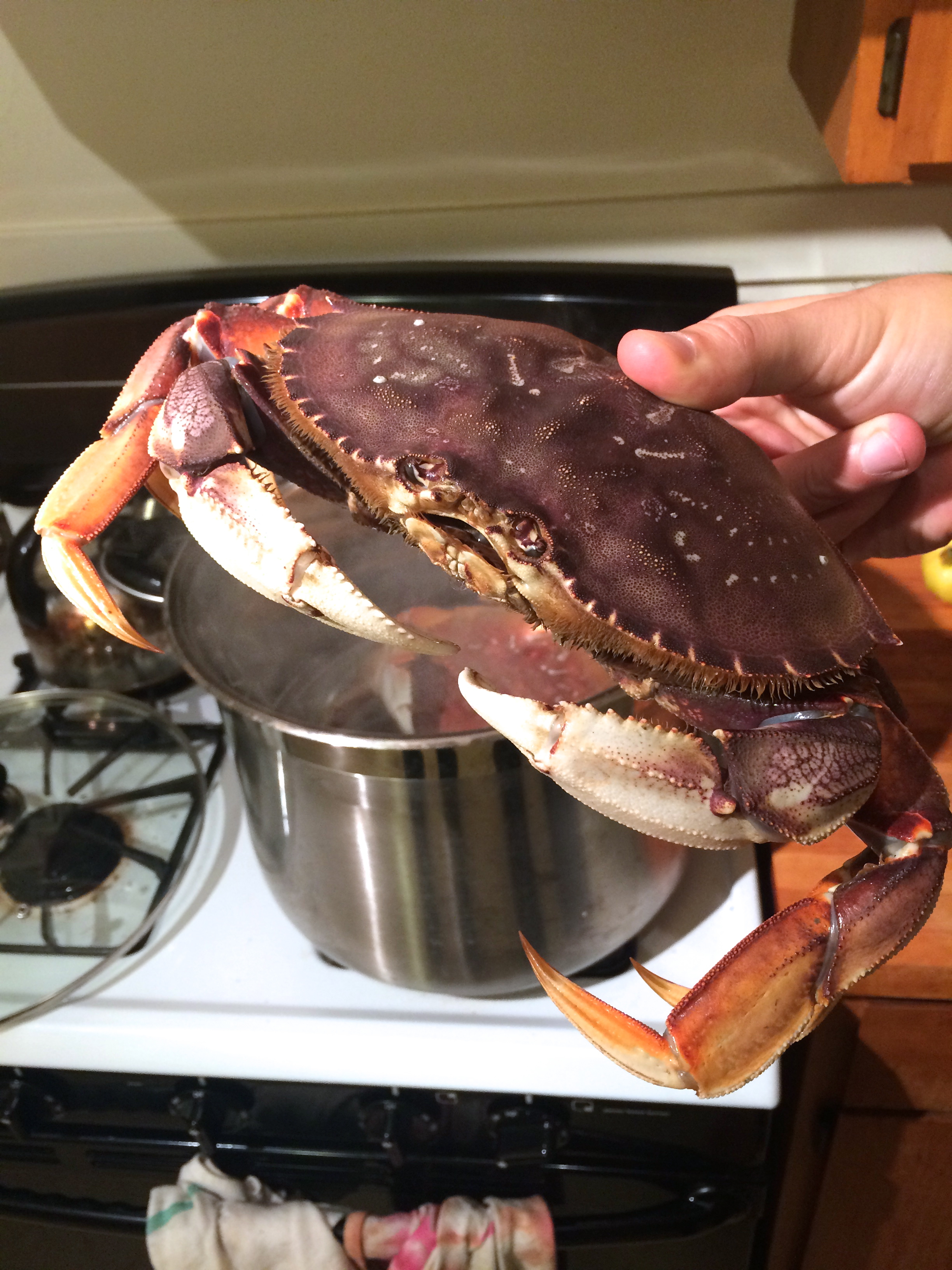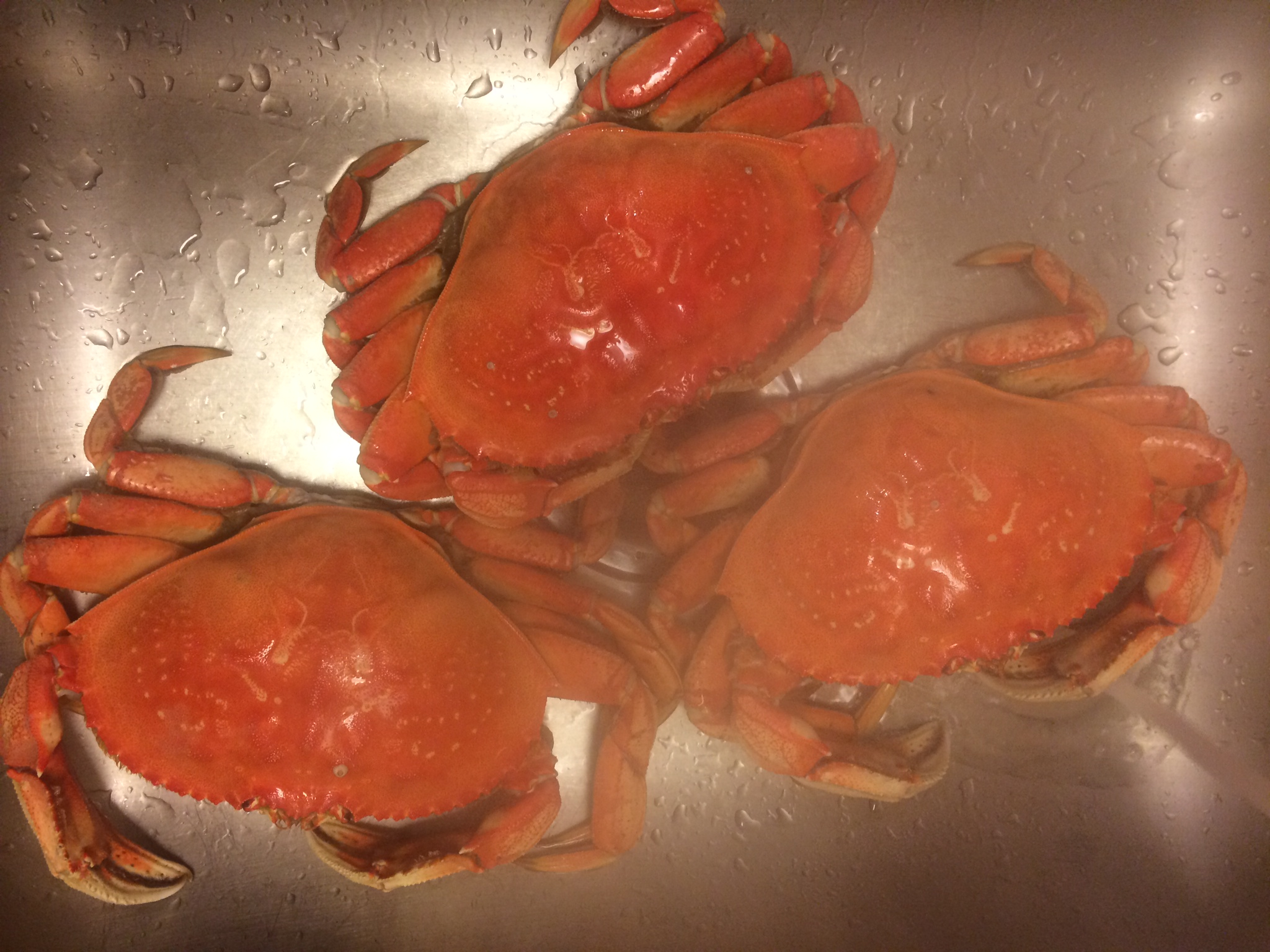Couscous Salad with Edamame, Feta, and Mint
This bright salad will make sure you know that spring has sprung. It's very fast to prepare and ideal for picnic-type gatherings. You'll be surprised how many people ask you for the recipe!
1 cup dry whole wheat couscous
Juice of 2 medium lemons
1/4 cup olive oil
1/4 cup white wine or rice vinegar
1/2 teaspoon salt
2 tablespoons lemon zest (use lemons above)
2 cups (10 ounces) fresh or frozen shelled edamame beans
1/2 cup finely diced mint
3/4 cup crumbled feta cheese
Bring 1 cup of water to boil and then remove from heat. Stir in dry couscous and cover with a lid. Allow to sit for 7 minutes, then remove lid and fluff couscous with a fork.
Whisk together lemon juice, olive oil, vinegar, and salt. Remember to zest lemon first for the next step.
Once couscous has cooled to room temperature, toss in zest, edamame, mint, feta, and dressing.
Serve cold or at room temperature.

Bouillabaisse with wild fennel
Classy and quick, the seafood stew of seafood stews.

My mother wasn't a typical Martha Stewart-like homemaker (sorry, mom), but she did have a few tricks up her sleeve and one of them was bouillabaisse (another was making things magical, but we're not going there right now). I grew up in a fish-loving area of Northern California and, even with a limited budget, we were able to get good, super fresh, seafood regularly. Bouillabaisse was one of those dishes that we requested for birthdays, made for special occasions, and always got excited about because it meant "special". As time moved on, we grew up and had more disposable income, which allow for a crab leg here, better fish there, and even an infamous (gasp) lobster tail on one occasion. These variations taught me about the adaptability of bouillabaisse, which I take with me when I prepare it now, adding shellfish and fin fish as available. The version below also includes a dash of Pastis, the anise-flavored liquor favorite from the south of France. Serves 4-6, preferably with crusty french bread or toasted crostini to mop it up.

1 tablespoon olive oil
A few wild fennel stocks and fronds (can substitute store-bought bulb/fronds)
1 medium yellow onion, chopped
3 cloves garlic, thinly sliced
2 cups fish stock
1.5 cups dry white wine
1 pound rock cod or other firm white fish
1 pound medium to large shrimp (I prefer with the peel)
14 ounce can diced tomatoes
1 pound fresh clams
2 tablespoon pastis, such as Ricard
1/2 teaspoon salt
1/2 teaspoon coarse ground black pepper
Chopped parsley for garnish
Dice the fennel stalks to yield ~1/4-1/2 cups. Pluck fronds and set aside for later use.
Heat the oil in a large pot over medium-high heat. Add the fennel stalk, onion, and garlic. Cook, stirring occasionally, until slightly tender, 3 to 4 minutes.
Add the fish stock and wine and bring to a boil. Add the rock cod, shrimp, and tomatoes and cook, covered, for 3 minutes.
Add the clams and cook, covered, until the cod and shrimp are cooked through and the clams have opened, 3 to 5 minutes.
Stir in the pastis, salt, and pepper. Sprinkle with the parsley and garnish with fennel fronds before serving.

Wanting the Unwanted: Why Eat Weeds
Wild food week 4/4 - 4/10!

What is the first food that comes to mind when you hear "foraged"? My guess is that a mushroom came to mind. While it's true that most mushrooms are grown in the wild, there's an abundance of other wild plant foods that are much easier to find and identify.
Just because these wild plants are out there, does that mean we should eat them? My colleagues and I of Berkeley Open Source Food (BOSF) are arguing yes. Here's why:
Nutrition:When the human diet shifted from hunting and gathering to agriculture some 10,000-20,000 years ago, we began the process of selecting certain monocultures for specific characteristics. Decreasing agricultural diversity had benefits, including population growth, but also led to a decrease in a variety of nutrients, particularly phytonutrients, causing the Western diet to have a much narrower range of nutrients today than it did thousands of years ago. These phytonutrients may reduce our risk for modern chronic diseases such as diabetes, heart disease, and cancer. Incorporating more wild foods into our diet might help reduce the risk of chronic disease.

Ubiquitous snack: the humble dandelion
Sustainability: It's no secret that California is experiencing a massive drought. These wild plants require no water beyond what nature provides, are largely drought-resistant, and are abundant in urban environments. Additionally, if we can make it profitable for farms to harvest and sell their edible "weeds" rather than compost them, we'll increase farm efficiency. Finally, of course we also all have Armageddon in the back of our minds (or at least I do) and knowing about wild edible plants will set us up for success when the time comes!
Culture: When was the last time you picked your food from the ground? How did it taste? Did it give you a warm fuzzy feeling? Research indicates that even children who are reluctant to try vegetables will do so if they have a hand in harvesting them and foraging is no different. By knowing where our food comes from, we're helping get back to where we started, if even just a bit, which will result in improved quality of life.
Gastronomy: Let's face it, new, crazy ingredients are fun. Even if you don't want to "get wild" with wild foods personally, it's exciting to go to a restaurant and have them introduce you to a new, delicious, local plant, no?

Gastronomy: Getting wild at the Chez Panisse tasting table with chefs from The Perennial/Mission Chinese Food, Mission: Heirloom, and (of course) Chez Panisse.

Tasting table notes.
So, the next question is - how do we get these tasty, nutritious, and abundant plants on people's plates? The answer is multi-faceted, exciting, and challenging. A few of the angles we're taking to tackle the issue include mapping wild edibles in "food deserts", investigating barriers to consumption (and identifying how to overcome these barriers), creating a supply chain and market for wild foods, and promoting consumption of wild edibles.
One project on BOSF's foraged plate now is Wild Food Week, which begins tomorrow (4/4) and runs through Friday 4/10. Our intention with Wild Food Week is to increase awareness of and interest in wild edibles with a series of events from a guided foragers’ walk to dinners at César, Chez Panisse, The Perennial/Mission Chinese Food, and Mission: Heirloom. We are working with several local farms to source the edible weeds and will debut a foraging field guide called The Bay Area Baker’s Dozen Wild Greens. See event details here.
It's been an exciting and eye-opening journey with many unique challenges. I look forward to telling you more about these challenges as well as a debrief on the events and our successes. For now, here's a sneak peak of the top 13 most common wild edibles in the Bay Area that we've included in the Bay Area Baker's Dozen Wild Edibles field guide. If you donate $15 or more to Berkeley Open Source Food, we'll mail you a field guide of your very own! Just be sure to mention this in the "additional details about my support" section. Donate here.













Here's an idea of what the field guide looks like - donate at least $15 to Berkeley Open Source Food and we'll send you one!

We've had a lot of press for this event - check it out!
http://www.eastbayexpress.com/WhatTheFork/archives/2015/03/31/slinging-weeds-wild-food-week
http://us7.campaign-archive2.com/?u=5da7f13757629775a7e122725&id=0b39e78e13&e=d87ccf06ab
http://www.citylab.com/work/2015/04/how-do-you-convince-people-to-eat-weeds/389357/
http://missionlocal.org/2015/04/for-wild-food-week-weeds-for-dinner/
http://www.nbcbayarea.com/news/local/Wild-Food-Week-298812881.html
References:
Gibbons, E., 1962. Stalking the Wild Asparagus, David McKay Co., Inc., NY, 303pp.
Robinson, J. “Breeding the Nutrition Out of Our Food”. The New York Times, 2013.
Craig, W. “Phytochemicals: Guardians of our health.” J Am Diet Assoc. 1997;97:199-204.
Spring Frittata with Asparagus, Leeks, and Chèvre
Spring sprung into a cast iron pan.
Celebrate spring by including asparagus and the bright flavors of goat cheese and tarragon in this elegant and satisfying meal. Frittata is a very easy way to whip up a stylish breakfast that’s also very durable and adaptable to a variety of dietary needs (well, apart from vegan that is, as eggs are necessary). This will solve your weekend brunch needs - don't worry, next weekend is just around the corner! Serves 6.
10 eggs
2 tablespoons fresh thyme leaves
1/2 teaspoon salt
1/4 teaspoon coarse ground black pepper
1 tablespoon unsalted butter
2 tablespoons olive oil
1 medium leek, trimmed and thinly sliced (use whites and greens)
16 asparagus spears, ends trimmed and chopped into 1.5-inch pieces
4-6 ounces chèvre (fresh goat cheese), crumbled
Preheat the broiler to high. Whisk eggs with thyme, salt, and pepper. Set aside.
Heat butter and oil in a large oven-proof pan over medium-high heat. Add leeks and cook, stirring occasionally, until softened, about 3 minutes. Mix in asparagus and continue to cook another 2-3 minutes until asparagus is slightly softened but still bright green.

Pour egg mixture over asparagus, stir once just to ensure even distribution of ingredients, and cook about 2 minutes, until almost set. Sprinkle with crumbled chèvre and broil frittata in the pan until golden brown, about 3-5 minutes (check and rotate if one side is cooking faster). Remove from oven and serve from pan or slide frittata onto a plate.
fennel, bulgur, & chicken salad with blood orange
A bright future for leftovers.
One of the most satisfying things to do in the kitchen is to reinvent leftovers and salads are a great way to do this as they allow for the addition of all kinds of bits and pieces. This recipe calls for chicken breast and provides cooking instructions, but there's no reason you couldn't chop up some leftover roast chicken, now is there? Along the same vein - no grapefruit? No problem - try oranges or even apples! Out of bulgur, but have some quinoa? Sounds great! Really - the possibilities are endless, but I really do enjoy this combination of the sweetly herbal, crunchy fennel and the juicy, rich blood orange paired with chicken and bulgur. Fantastic for lunches or picnics. Serves 4 as a main.

1 cup dry bulgur
Two 6-ounce boneless chicken breasts (preferably skinless)
2 tablespoons grapeseed oil, divided
1/8 teaspoon sea salt, divided
3 medium blood oranges
Juice from 1 lemon
1 large fennel bulb, with fronds (try wild fennel stalks and fronds!)
1/4 cup diced fresh green onion
Salad greens (optional)
Preheat the oven to 500 degrees F.
In a saucepan, combine bulgur with 1 cup water and bring to a boil. Cover, reduce heat, and simmer for 10-12 minutes, or until tender. Set aside to cool.
Meanwhile, coat the chicken breasts with 1/2 tablespoon of grapeseed oil and sprinkle with about half of the salt. Lay the chicken on a baking sheet and bake on the top oven rack for 15 minutes or until cooked through - flip the chicken halfway through cooking time. Allow to cool and then slice into 1/4-inch thick strips.
Cut oranges in half. Squeeze the juice from one of the halves into a small bowl or jar. Add the remaining grapeseed oil, salt, tablespoon of olive oil, and lemon juice to the blood orange juice. Whisk or cover jar and shake until thoroughly combined.
With a knife, remove the peel and outside pith of the remaining 5 orange halves. Slice into wedges. It's helpful to know how to segment citrus like a boss.
Remove the fronds from the fennel bulb and thinly slice the bulb. Chop several of the fronds, enough to fill 1/2 cup.
Toss bulgur with dressing, chicken, orange wedges, fennel bulb, fennel fronds, and green onion. Serve at room temperature or cold atop salad greens (if desired).
Preheat the oven to 500 degrees F.
In a saucepan, combine bulgur with 1 cup water and bring to a boil. Cover, reduce heat, and simmer for 10-12 minutes, or until tender. Set aside to cool.
Meanwhile, coat the chicken breasts with 1/2 tablespoon of grapeseed oil and sprinkle with about half of the salt. Lay the chicken on a baking sheet and bake on the top oven rack for 15 minutes or until cooked through - flip the chicken halfway through cooking time. Allow to cool and then slice into 1/4-inch thick strips.
Cut oranges in half. Squeeze the juice from one of the halves into a small bowl or jar. Add the remaining grapeseed oil, salt, tablespoon of olive oil, and lemon juice to the blood orange juice. Whisk or cover jar and shake until thoroughly combined.
With a knife, remove the peel and outside pith of the remaining 5 orange halves. Slice into wedges. It's helpful to know how to segment citrus like a boss.
Remove the fronds from the fennel bulb and thinly slice the bulb. Chop several of the fronds, enough to fill 1/2 cup.
Toss bulgur with dressing, chicken, orange wedges, fennel bulb, fennel fronds, and green onion. Serve at room temperature or cold atop salad greens (if desired).
Celeriac Soup with Truffle Oil and Chives
Get gnarly.

As was demonstrated with celeriac chips, celery root can produce foods you would not expect from it's rugged exterior. Instead of a delicately crispy chip, this time celeriac is transformed into a silky, rich, and elegant soup. There are a lot of directions you can take a blended root vegetable soup, such as the addition of bacon or blending with apples, but I think this combination of nutmeg, chive, and truffle oil is ethereal and satisfying. Serves 4.

1 tablespoon butter (can substitute olive oil if a vegan soup is desired)
1 tablespoon olive oil
1 large leek, trimmed of rugged dark green leaves and thinly sliced
1/4 teaspon sea salt, plus more to season as needed
1-2 garlic cloves, peeled and thinly sliced
One large celery root (about 1.5-pounds), peeled and chopped into cubes
2 cups chicken stock (can substitute water or vegetable stock if a vegan soup is desired)
2-3 cups water
1.5 teaspoons freshly-ground white pepper
Fresh nutmeg, to grind over top
Truffle oil, to drizzle
About 2 tablespoons diced fresh chives (a little less than most bunches)
In a large pot, melt butter with olive oil on medium low heat.
Add the leeks and garlic and cook for about five minutes, stirring frequently. Add the salt and continue to cook until the leeks and garlic are soft and translucent, about another 5 minutes. If the pot begins to brown too much on the bottom as they cook, add more butter or olive oil.
Add the celery root, stock, and 2 cups water. Bring to a boil, then reduce to a strong simmer. Cook, with the lid to the pot ajar on top, until the celery root pieces are soft and easily pierced with a paring knife, about 30-45 minutes.
Add white pepper then purée using an immersion blender, or let the soup cool to room temperature and purée in a food processor until smooth. Taste season with additional salt and pepper if desired. If the soup is too thick, it can be thinned with remaining part of cup of water to desired consistency.
Serve with a drizzle of truffle oil, a few gratings of nutmeg, and a scatter of chives.
Tsukune (Chicken Miso Meatballs) with Nettle Salsa Verde
Izakaya meets foraged greens.

When I have (what I think to be) a unique recipe idea and then find that idea somewhere on the internet, it makes me both happy and sad - happy that the idea is good enough to already be out there and sad that it's already out there. Fortunately, I typically adjust the ingredients enough and add an unusual accompaniment, such as this foraged nettle salsa verde, to make the recipe all my own. The nettle was a volunteer in my snap pea patch and works great as a bright, yet earthy, pairing to the light-bodied and savory tsukune. Remember to be careful when foraging or harvesting stinging nettle - it stays true to its name! Tsukune recipe adapted from here. Serves 4-6.

1 bunch stinging nettles, about 2 cups packed leaves after blanching
1 shallot, chopped
1 clove garlic, chopped
About 1/4 teaspoon sea salt
2-3 tablespoons rice vinegar
1 tablespoon water
1.5 pounds ground chicken, preferably dark meat, divided
1 cup minced scallions (about 4)
1.5 tablespoons white miso
1 tablespoon soy sauce
1 tablespoon brown sugar
1 tablespoon sesame oil
About 1 tablespoon grapeseed or other neutral oil
Shichimi tōgarashi, for garnish
Bring a large pot of water deep enough to submerge the nettles to a boil. Submerge the nettles and cook for 3 minutes.
While nettles are cooking, prepare an ice water bath. Transfer the nettles using tongs to the ice water, cool, then drain and squeeze out excess water. Remove very large or tough stems from the nettles, discard, and blend the remaining leaves and smaller stems in food processor until chopped. Add shallot, garlic, and salt and pulse then incorporate vinegar and water until a texture resembles a coarse salsa. Set aside or refrigerate if preparing more than one hour before making meatballs (can be made up to 24 hours in advance).
Heat a small nonstick skillet over medium heat. Add 1 pound ground chicken and cook, stirring frequently breaking apart pieces, until chicken is opaque and just cooked through, about 2 minutes.
Combine cooked chicken, remaining raw chicken, scallions, and miso in a bowl. Mix together with your hands until a homogenized, sticky mixture forms. Divide mixture into 16-20 meatballs of the same size. Whisk together soy sauce, brown sugar, and sesame oil and keep nearby for use in the next step. If your salsa verde is in the refrigerator, this would be a good time to bring it out to allow it to come to room temperature.
Heat enough grapeseed oil in a large sauté pan to lightly coat pan on medium high. Add meatballs and cook on one side for 2-3 minutes until lightly browned. Drizzle half of soy mixture over meatballs then flip, turn down heat and cook another 2-3 minutes, turning occasionally so that all sides are well-cooked.
Serve meatballs over nettle salsa verde with a drizzle of the remaining soy mixture and sprinkling of shichimi tōgarashi.

Caldo Verde Verde
An even greener spin on an already green soup.

Caldo verde is a traditional Portuguese soup made from potato, chorizo, garlic, and a bunch of leafy greens, such as kale or chard (there’s no reason why you couldn’t use all or partial amount wild greens here either). In this spin, I include even more greens to the recipe by way of parsley and cilantro to give it just a bit more brightness, complexity, and of course, to make it even greener. March is a great time to get into green!
A few friends and I have been doing what we call "#craftsoup" nights where the host prepares soup and everyone crafts as they eat. The purpose of soup is a meal that's easy for the host and easy to eat while you're crafting. I'm always on the lookout for soups to prepare for these nights that are simple, quick, crowd-pleasing, and a complete meal in themselves (one of the rules of #craftsoup night is the host doesn't make anything beyond soup, though I break that rule often). This meal definitely checks all of these boxes and any soup that includes a pound of green leafy vegetables while tasting rich and satisfying has my vote! Serves 4 as a main course, 6-8 as a side.

“The soup can be “veganized” by using sautéed mushrooms instead of the chorizo and replacing butter with olive oil. ”
1 tablespoon extra-virgin olive oil, plus more for drizzling
1 tablespoon unsalted butter
3 garlic cloves, diced
1 large yellow onion, chopped
4-5 ounces chorizo (I like to use Palacios brand purchased at Berkeley Bowl), sliced 1/4 inch thick
2 cups water
2 cups chicken stock
3-4 Yukon Gold potatoes (about 1.25 pounds total) chopped
2 teaspoons white pepper (preferably freshly ground)
Salt to taste
1 pound Red Russian kale (about 1 large bunch), stems discarded and leaves finely sliced - no reason why you couldn’t use wild greens such as dandelion or dock here.
1/2 cup combination of fresh parsley and cilantro, diced (cilantro can be replaced by parsley for the cilantro-haters out there)
Heat the tablespoon of olive oil and butter in a large pot on medium low. Add the garlic, onion and half of the chorizo and cook, stirring occasionally, until the onion softens, about 6 minutes.
Add the water, broth, and potatoes and bring to a boil. Simmer until the potatoes are tender, about 15 minutes.

A great trick for chopping the greens into thin strips is to layer the leaves, roll up, and chop multiple leaves at the same time.
Using an immersion blender, purée the soup and add white pepper and salt to taste. Bring the soup to a boil. Add the kale and remaining chorizo (reserving a few pieces of chorizo for garnish) and simmer until the kale is wilted, about 3 minutes. Just before serving, stir in herbs, drizzle with olive oil and garnish with chorizo and herb sprig.
Serve with: Buttermilk cornbread

Segment Citrus "Like a Boss"
A mature approach to citrus in salads.
Update: I just found out when I made an olive oil cornmeal cake with blood orange that this technique has a name - supreming. Who knew!
A good salad in a restaurant will have something that's lacking in a salad made at home. This something is love - enough love for a salad that you'll put in a little effort. Now, I'm not naming any names, but I'm sure we've all been there - salad as an afterthought. Of course, there's always room for a simple green salad with any meal, but sometimes you want to "get a little fancy".
One trick for doing so that I picked up while working at restaurants is segmenting citrus like a boss. By using this simple technique, your citrus segments reveal only flesh, rather than the surrounding pith and are colorful, shiny, and juicy. Here's what you do:

Cut peel off of citrus fruit.
Cut away the peel from the citrus fruit by slicing off each end and cutting down the edge of the fruit to reveal the flesh.
Cut out segments from pith around edge of the fruit.
As you get toward the end, it can be difficult to segment them perfectly, but don't worry, you can slice through the pith at this point. I also like to squeeze the juice from the edges and remaining pith into the salad dressing.


Cut into flesh to remove segments.

Removing beautiful segment.
Ashes to Ashes cocktail
A delicious way to ease into a meal that is lightly boozy without being boring or too sweet.

My usual go-to cocktails fall in the "highly alcoholic" arena because that's typically what I'm looking for, but sometimes you want to start out a little mellower. Unfortunately, it can be hard to find a drink that is lower in alcohol without being sweet or tasting watered down. This combination of fernet, rosemary honey, and lemon does a great job of whetting the palate without making you feel like your missing out.
I came across this combination at a.kitchen + bar in Philly where my friend I used to work with at the Nordic Food Lab is now cheffing. The food and a.kitchen is delicious, but a little intense, so starting with this light herbal aperitif was definitely the way to go (before drinking wine, of course). We requested the recipe and have had a fun time recreating the drink at home using foraged rosemary that is beginning to flower, making for an even more appealing garnish.
1.5 oz Fernet Branca
0.75 oz rosemary honey syrup (see below)
0.5 oz lemon juice
0.25 oz ginger syrup
Sparkling water
Fresh rosemary sprigs for garnish
Shake all ingredients apart from sparkling water and rosemary garnish, double strain, then top with sparkling water to fill glass (adjust water according to taste). Garnish with rosemary.
To make honey-rosemary syrup (you might as well make a batch of it for future drinks!):
Simmer 2 parts honey to 1 part water with 1 rosemary spring for about 10 minutes. Remove from heat, cool, then remove rosemary.
Moroccan "Chick-Chick" Salad
Chick peas and chickweed unite.

This salad is a fun play on "chickweed" and "chickpeas" blended together with the Moroccan flavors of pomegranate, cumin, and possibly feta.
My list of favorite foraged greens is long, but chickweed *might* be in the top 5. If not the top 5, then definitely the top 10. Lucky for me, it is one of the most abundant "weeds" available and is also drought resistant - armageddon? Sign me up!
In the Bay Area, you'll find chickweed in abundance after rains when the sun inevitably returns and all the greens start poking up. What I love about this wild green is how soft and delicate the greens are, both in flavor and texture, while still having a slight crunch and very fresh flavor.
To identify chickweed, look for a sprawling plant with oval pointed leaves and possibly small white star-shaped flowers. The most obvious identifying characteristics are:
It does not have milky sap
It has one line of hairs on the side of the stem
If you pull gently on the outer part of the stem, it will separate and there will be a thin inner part that does not separate (try a few times, it might take a bit to get the hang of it)
Some recipes call for cooking chickweed, but I think it's best raw or, maybe, slightly wilted over a soup or by the hot chickpeas in this salad. Serves 2.

3/4 cup cooked chick peas
1 tablespoon plus 2 teaspoons olive oil, divided
1/2 teaspoon cumin
Sea salt
1 tablespoon lemon juice
1 teaspoon pomegranate molasses
4 cups chickweed, washed and dried
1-2 ounces crumbled feta (optional)
Heat cast iron with about 2 teaspoons of olive oil on high. When cast iron is hot, add the chickpeas. Cook, stirring periodically, until beans are lightly browned, about 5 minutes. Once cooked, place in bowl and toss with cumin and a few pinches of sea salt.
“The term “chickweed” is based on the fact that chickens love it —- cute!”
Add lemon juice, pomegranate molasses, remaining olive oil, and a pinch of salt to a mason jar. Whisk with a fork or cover jar and shake to combine.
Combine chickpeas with chickweed in a bowl, drizzle with dressing, and top with crumbled feta (if desired). Serve immediately.

Moroccan chick-chick salad with optional feta.
Herbed Spaghetti Carbonara
Rich simplicity at its finest bolsted with aromatics.

I've thought about making spaghetti carbonara several times, ever since I was introduced to it in a Ruth Reichl book, but I never did until faced with a nearly empty refrigerator (that fortunately did happen to have very good quality bacon). The rustic simplicity of the dish was always intriguing, but the shear absence of vegetables and color in a main course turned me off. I have to say that when I did finally make I was not disappointed - by tossing in fresh aromatic herbs a pleasant brightness was achieved that balanced the bacon, egg, and garlic.
The coolest thing about spaghetti carbonara is the fact that you cook the egg by tossing them with the freshly cooked pasta. Egg proteins are very sensitive and even just that small amount of heat is enough to denature and partially coagulate them - in other words, the raw egg starts to thicken as the proteins unwind and join back up. This creates a lovely silkiness akin to a fancy sauce only using egg. This is a great recipe to have in your arsenal for when you don't have time and aim to please. Below recipe serves 2-3 and is adapted from Ruth Reichl's recipe.
“As the ingredients are minimal, fresh pasta is really the way to go if you can, but it is not necessary. ”
1 pound of spaghetti or angel hair pasta, preferably fresh
1/4 pound thickly sliced good quality bacon, about 3 thick strips (I got mine from The Local Butcher Shop in North Berkeley and it made a huge difference)
2 cloves garlic, peeled and halved
2 large eggs
1/8 teaspoon (or a few grindings of) black pepper
1-2 handfuls of plucked fresh herbs such as oregano, thyme, and marjoram
Grated parmesan cheese, to top pasta
Bring a large pot of water to a boil for the pasta. If making fresh pasta, complete the below steps before cooking the pasta and if using dried pasta, complete the below steps while the pasta is cooking.

Cut the bacon into thick pieces, about 1/2-inch wide. Cook on medium-high in a skilled until fat begins to render, about 2 minutes. Add the garlic and cook another 5 minutes, until edges of bacon become crisp.
Break the eggs into the bowl you are going to serve the pasta in. Add black pepper and beat with a fork.
Once pasta is cooked (1-2 minutes for fresh, 8-10 minutes for dried), drain and mix with the eggs. Add the bacon and garlic mixture with about one-half of its fat (or more if preferred) along with the fresh herbs and toss into pasta. Serve with grated parmesan and more black pepper if desired.
Dark Chocolate and Cardamom Truffles
Put your own spin on this decadent favorite.
Valentine's Day is just around the corner - forget the store bought, everyone would prefer homemade confections! This recipe very easy recipe is also reliable and adaptable, but it does take patience. I’ve also made variations with raspberry jam, orange marmalade, rum/coconut, and black pepper.

8oz bittersweet or semi-sweet chocolate (go high quality, you won’t regret it), very finely diced or shaved
1/2 cup heavy cream
1-2 Tbs brandy
1 tablespoon medium grind coffee
Sea salt, for sprinkling
Unsweetened cocoa powder, for dusting
Place diced chocolate into a large heatproof bowl. Bring cream just to a boil in a small saucepan over medium-high heat; pour over chocolate in bowl. Stir in brandy and coffee. Cover with plastic wrap; let stand 10 minutes. Stir until smooth. Let stand until thick, about 15 minutes.
Pour chocolate mixture into a shallow 8-inch dish or pie plate and sprinkle with sea salt, if desired. Cover with plastic wrap, and refrigerate until mixture is very cold and set but still pliable, about 30 minutes.
Using a teaspoon or a 1/2-inch melon baller, scoop balls of chocolate mixture, transferring them to a baking sheet lined with parchment paper as you work. Refrigerate truffles 10 minutes.
Using hands dusted with cocoa powder, dip each truffle in cocoa powder to coat, then quickly shape truffle into a rough round. Refrigerate truffles in an airtight container until ready to serve, up to 2 weeks; before serving, reshape into rounds, and roll each truffle in cocoa powder, if desired.
German Apple "Cake"
The cake for pie lovers.

This is really more of a pie with a larger, fluffier crust than a cake (hence the quotation marks). I first encountered a version of this recipe on Culinate where I was immediately smitten by the idea of a pie-ish cake, typically preferring the former to the latter myself. I made a few additions and baked it in a cast iron pan to bring it to what it is today. Its refined rustic-ness makes it comforting as a dessert and delightful as an afternoon snack with cheese and tea or coffee. Or a beer, really - try it! Serves 6 and can easily be doubled to serve 12.




1 cup flour - I like to use a blend of something like half rye or other whole grain and half all purpose
1/3 cup sugar
1/8 teaspoon plus one pinch salt
1 tsp baking powder
1/4 cup (1/2 stick) cold unsalted butter, diced
1 large egg
1/2 tsp vanilla
1/2 cup crème fraîche or yogurt, divided (optional)
3-4 medium apples
1 tablespoon lemon juice
Up to 2 tablespoons brown sugar
1/8 teaspoon allspice (or other warm spices such as cardamom, clove, nutmeg, and cinnamon
Dash of apple brandy (optional)
Ice cream (optional)

In a large bowl, mix together the flour, sugar, 1/8 teaspoon salt, baking powder, and butter. Work this mixture with a pastry blender or fork until it resembles coarse cornmeal.
Make a well in the center of the flour mixture and add the egg and vanilla. Mix the eggs and vanilla slightly with a fork, then gradually whisk in the flour mixture. Work and knead until the mixture forms a coherent mass and is moist but not sticky. If sticky, add a little more flour and knead it in. If too dry, incorporate crème fraîche, yogurt (milk or water also works) one tablespoon at a time (up to 2 tablespoons) until dough is moist.
Cut the dough in half and roll each half into a ball. Flatten the halves a bit, cover with plastic wrap, and allow to chill for 30-45 minutes in the refrigerator.
Preheat the oven to 350 degrees. Butter an 8-inch cast iron pan. Core and slice the apples (they can be peeled, I like to keep the peels on), then toss them in a bowl with the lemon juice, brown sugar (more or less, depending on apples and preference), allspice, pinch of salt, and optional dash of apple brandy.
Take the dough out of the refrigerator about 5 minutes prior to rolling. Sprinkle one dough ball with flour, flip, sprinkle with more flour, and roll out on plastic wrap until is will fit snugly into the bottom of the cast iron pan. The dough can be a bit sticky, so add a little extra flour as needed. Lifting the plastic wrap, invert it into the cast iron pan.
Pile the apple mixture on the dough and rearrange apples to minimize large pockets of air. Roll out the remaining dough as you did before, but a little larger than first (so it can fit over top of apples) and place it over the apples by inverting the plastic wrap as you did the previous time. If the dough breaks, don't worry - just press it back together.
Bake the cake for 45 minutes or until the crust is golden brown and your house smells marvelous.
Serve warm, with crème fraîche or ice cream and mint garnish if desired. Also great in the afternoon with cheese.

This German apple cake pairs wonderfully with cold apple brandy/calvados.
Fermented Beetroot-Apple Relish with Star Anise and Cloves

Salt fermentation is one of the greatest things out there. By adding salt, you keep out the bad microbes and foster an environment to the good microbes to "do their thing". Namely, to eat up the sugar and proteins and create new, delicious flavors and textures.
Additionally fermented foods, such as this relish, contain probiotics to help you digest almost anything. Fermenting foods at home can be intimidating, but once you get the hang of it, you can let the microbes do the work for you! Relish is great paired with sausage, smoked fish, potatoes, or on a cheese plate. Makes 16 ounces.
1 large red beet
1 large apple
1 whole star anise
3 whole cloves
1 teaspoon sea salt, plus more if needed
Sterilize one wide-mouthed 16-ounce mason jar by washing with soapy water, rinsing, and then submerging in boiling water for 15 minutes. Remove from water and set aside to air dry.
Peel and shred beet and apple using cheese grater and toss with star anise and cloves. Incorporate salt by sprinkling in 1/4 teaspoon at a time and stirring.
Scoop shreds into mason jar and mash with a wooden spoon to release their juices. The shreds should be entirely submerged, as the salty water from the beet and apple mixture will keep oxygen and bad bacteria out. If they are not, then create a brine by dissolving 1 teaspoon sea salt in 1 cup filtered water and pour this over the shreds until they are completely covered.
Cover with cheese cloth or clean towel and ferment at room temperature for 3-4 days or longer, depending on your desired level of sourness. The longer you let the relish ferment, the more sour it will become.
Once relish is the level of sourness that you desire, cover and refrigerate. Use within 6 weeks. Relish can also be processed in a blender or food processor if you desire a pastier texture.
Pasta Pomodoro with Tuna and Capers
Warm up quickly with spicy tomato and tuna pasta.
“If you want to use fresh pasta in this recipe, simply switch the order of preparation to make the sauce first and cook the pasta while the sauce is simmering, as fresh pasta takes only 1-2 minutes to cook. ”
I'm not glutenphobic or a carb-hater by any means, but my go-to meals at home in my adult life have rarely been pasta. Bulgur, barley, buckwheat? Definitely, but pasta? Infrequent, if ever. This routine changed when my pasta maker-wielding partner moved in. Making pasta from scratch transforms it from a vehicle for sauce and other ingredients to a culinary star that shines all on its own. It has also allowed for experimentation with combinations of flours, such as spelt and semolina.
The inspiration for this recipe came from a dinner at Boot and Shoe Service, with adaptations including whole wheat spaghetti in place of classic, more tuna in the sauce, and red pepper flakes. The great thing about this pasta is it can be made almost entirely from ingredients you probably already have in your kitchen right now (or you can purchase at any time because they do not go bad) and it's incredibly quick, as a pasta meal should be. Serves 2.
“For homemade pasta, use a 1:1 combination of spelt or whole wheat and semolina flours. ”
4 ounces whole-wheat spaghetti
1 tablespoon plus one teaspoon extra-virgin olive oil
1 clove garlic, minced
1 oil-packed anchovy, chopped (optional)
1 14-ounce can diced tomatoes, drained (reserve water)
1/8 teaspoon crushed red pepper flakes
1 can (5 to 6-ounces) good quality tuna, drained and flaked*
1-2 tablespoons California capers (or 2 teaspoons conventional capers)
1 tablespoon minced fresh parsley
Grated parmesan cheese and black pepper (optional)
Bring a large pot of water to a boil. Cook spaghetti to “al dente” (cooked, but still firm), for 9-11 minutes or according to package instructions. Drain and toss with 1 teaspoon olive oil.
Heat remaining tablespoon of oil in a large skillet over medium. Add garlic and anchovies and cook until garlic is golden, stirring and breaking up anchovy with a wooden spoon, about 2 minutes.
Add tomatoes and crushed red pepper flakes and simmer, stirring occasionally, for 15 minutes. Add reserved water from the tomato can as needed to prevent tomatoes from sticking to the skillet.
Once tomato consistency is sauce-like and thick, stir in tuna and capers and cook for another 2 minutes. Divide sauce evenly over cooked pasta and top with parsley and optional parmesan and black pepper. Serve hot.
*To use oil-packed tuna, drain the tuna and use oil from can in place of olive oil. Also be sure to refer to the Monterey Bay Aquarium Seafood Watch Guide for sustainable canned tuna choices.
Serve with: Roasted cauliflower-kale salad with citrus peel and nutmeg.
Fresh Crab with Wood Sorrel-Cilantro Sauce
Ocean strawberries meet wild wood sorrel.
Crab season is one of my favorite seasons of the year. I love the fact that we still rely on fishermen and women to brave the seas in order to bring us these delicious crustaceans. Growing up in Humboldt County, my family lived near a crab stand that purported the clever phrase of "ocean strawberries" on their sign and I like to think of them as a cross between this elegant description and giant bugs.
In our house crab alone was special enough and accompaniments didn't go beyond melted butter and crusty bread. Although I still agree that crab is special enough, I wanted to take advantage of the wild wood sorrel prevalent in my neighborhood by making a vibrant and spicy dipping sauce of wood sorrel, cilantro, serrano, and sesame.
“Many plants, including wood sorrel, contain oxalic acid, which can be toxic in large quantities. Remember to enjoy in moderation.”

Wood sorrel looks like clover, but with yellow flowers on long stems. These are the somewhat fleshy flower stems you may have chewed on as a child walking around town (at least I did) to release their sour juices. The juice or ground leaves can be used as a unique way to provide a lemony kick to sauces or as a bright garnish - a little goes a very long way. Wood sorrel is high in Vitamin C and some use the plant medicinally for liver and digestive issues, but these latter benefits are not confirmed by research. The reason why wood sorrel is so lemony is due to its oxalic acid content, which can be toxic if eaten in large quantities and those with kidney or intestinal problems and pregnant women should avoid it. However, other plants contain oxalic acid as well so the general rule of thumb it to eat wood sorrel in moderation, meaning using some in sauce or as a part of a salad or garnish every once in a while is fine, and consume in combination with a balanced diet. There are also no dangerous look alikes for wood sorrel, making it a great foraged food for newbies! The below recipe serves 4.
2-4 fresh crabs (2 for half a crab each, 4 for heavy crab eaters)
1/2 cup wood sorrel leaves
2 serrano peppers, chopped with seeds removed
1 cup cilantro, chopped
Juice from 1/2 lemon
1 tablespoon ponzu (can substitute 1 teaspoon soy sauce + 2 teaspoons water if needed)
1 teaspoon yellow miso
1-2 tablespoons toasted sesame oil
Cooking and cleaning the crab: Go here for more information and step-by-step photos.



Get a large pot of water to a rolling boil. There should be enough water to cover the crabs. Throw your crabs in and cook them for ~7-8 minutes per pound. That's 7-8 minutes for the average weight of the crabs, not total weight. So, if I have 2 crabs that weigh 1.5 pounds and 2 pounds respectively, I should cook them for about 12-14 minutes. Round down when possible, as you can always cook the crab more if needed, but crab cooking is pretty forgivable. The crabs will change from a purplish color to a bright orange-red.
Remove crabs and rinse under cool water until cool enough to handle.
“Protip: All crabs available to eat are male, as the female are thrown back in to encourage population growth. ”
Turn the crab upside down. Stick your finger underneath the "apron" (little tail looking thing) and pull it off. Remove the carapace (large back shell) by putting finger in hole where apron was and ripping the back shell from the legs. It's actually pretty easy and fun.
Rinse off or save the guts (yellow gushy stuff) found in the carapace. The guts can be eaten on rice, in a stew, or on their own if desired.
Remove the gills (spongy soft jagged things) from either side of the body as well as the mandible (sharp mouthparts in the front).
Give the body a final rinse - remove the greenish-brown and yellow goop - and break the body in half if desired. Serve at room temperature or cold with wood sorrel sauce (below).
To make the wood sorrel sauce: Simply blend all ingredients except sesame oil in a food processor or immersion blender. Drizzle in sesame oil until desired flavor and consistency is achieved.
Here's a quick video demonstrating how to clean a Dungeness Crab:
Foraging Mussels
The easy street to self-sustaining.


If you haven't been mussel foraging, it's easier than you think - I guarantee it. All that it requires is a little bit of forethought, gloves, and a bucket. The last time I went to Baker Beach in San Francisco and there were tons of mussels clinging to a few rocks and our buckets were filled in no time. Yes, the mussels can be a bit rugged in texture, but believe me, they're worth it! Here's what you need to know and do before you forage mussels in California:
Only go during the months from November to April. From May to October mussels are quarantined due to potential paralytic shellfish poisoning - not something you want to mess with.
Call the California Shellfish Biotoxin Information Line at 1-800-553-4133 to double check that waters are safe at the time that you plan to go (sometimes the quarantine for longer periods depending on weather and water conditions).
Stop by a drugstore and pick up a one-day fishing permit or purchase one online from the CA Department of Fish and Wildlife and bring it with you, otherwise you are subject to fines.
Go at low tide: Foraging mussels is best at low tide and mussels can often be found clinging to rocks near the water.
Mussels can only be pulled by hand, do not use other instruments, such as screwdrivers or crowbars.
Bring: Thick gloves, as the mussels can be sharp and a bucket, to hold your booty.
There is a collection limit of 10 pounds (in the shell) per permitted collector per day.
For more information about regulations, visit the CA Department of Fish and Wildlife.


Royal Pomme Punch
Nothing says party like punch.
Retro punch is the best way to throw a classy party without having to play bartender. Be aware - punch disappears faster than you would expect and is very strong. I love this punch, and all old-school punches, because they use interesting blends of ingredients and usually contain bubbly, so you know it's a party! This one is great for the winter (and Winter Solstice parties) because the blood orange keeps things bright and festive, while still being dark and cozy. I usually double the below recipe for parties, but one batch will serve about 15-20 people.

12 ounces (350 mL) apple brandy or apple jack, such as Laird's Apple Jack
500mL (about 3/4 bottle) Dubonnet rouge
1/4 cup fresh blood orange juice
3 blood oranges, sliced into rounds
1 bottle of champagne or other sparkling wine
20 dashes of Angostura bitters
After mixing, throw in a giant ice cube for extra classiness. A giant ice cube can be made by freezing water in a square tupperware container overnight. You might want to store a back up of all the ingredients except champagne and bitters to allow for easier refill (your guests will love to watch you dash in the bitters).
Enjoy and be careful - again, it's strong and tasty!
Roasted Delicata Rings with Tahini
Rich tahini sauce perfectly complements loops of winter squash.
This is the dish - the dish that you can bring to any gathering and it will be well received. Being vegan, gluten-free, allergen-friendly, and pseudo-paleo (to all but the very strict of paleos), you'll get "oohs" and "awes" from all people present. Beyond that, it's delicious, provides healthy fats, and requires no utensils! Serves 4 as a side.

2 medium delicata squash (about 1.5 pounds)
1/4 cup olive oil, divided
About 1/2 teaspoon sea salt
3 cloves garlic, diced
1/4 cup tahini (sesame seed paste)
Juice from 1 lemon
2-3 tablespoons water
Pomegranate seeds and fresh herbs for garnish (optional)
Preheat oven to 425 degrees F.
“Delicata seeds are can be roasted along with the squash if desired. Simply rinse, pat dry, drizzle with olive oil, salt, and other seasonings of choice, and roast for 7-8 minutes, tossing halfway through.”
Clean the delicata squash well. Slice into rings 1/2-inch thick and remove seeds and pulp from squash rings using a spoon or a knife. It is okay if some pulp strands are left, as they will not be noticeable once roasted.
Place delicata rings on a baking sheet and using your fingers, toss with just enough olive oil to coat (about 1-tablespoon). Be careful with the oil - too much will make the squash soggy. Spread rings out in a single layer.
Sprinkle with one pinch of salt per pan and roast about 12-15 minutes on each side until soft and browned on edges.
While squash is roasting, blend garlic with tahini, lemon juice, and 1/4 teaspoon salt using a food processor or immersion blender. Blend in remaining olive oil and enough water to create a thick, fluffy sauce.
Remove squash from oven, allow to cool to room temperature, and serve with tahini sauce for dipping. Garnish with pomegranate seeds and fresh herbs (optional).








































